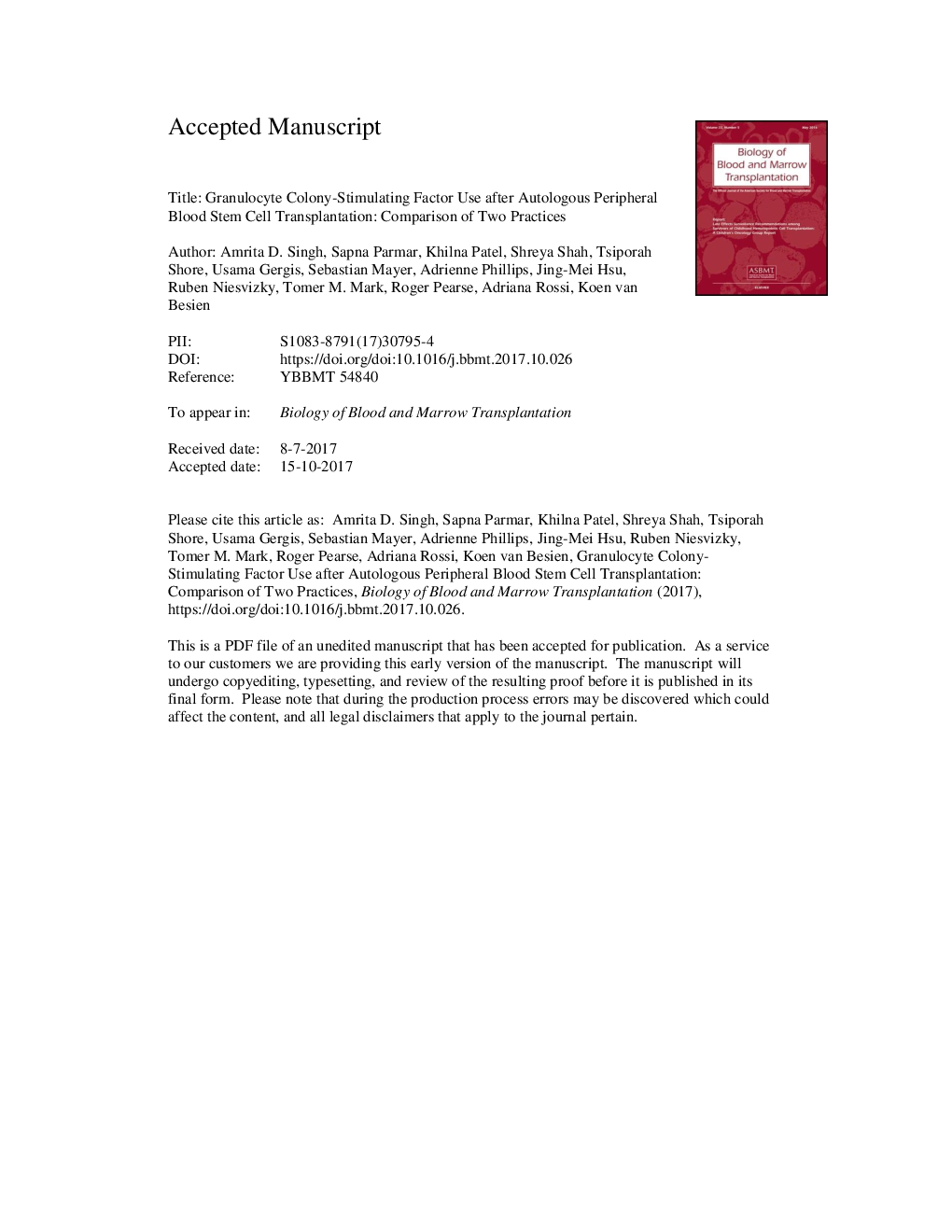| کد مقاله | کد نشریه | سال انتشار | مقاله انگلیسی | نسخه تمام متن |
|---|---|---|---|---|
| 8430295 | 1546232 | 2018 | 19 صفحه PDF | دانلود رایگان |
عنوان انگلیسی مقاله ISI
Granulocyte Colony-Stimulating Factor Use after Autologous Peripheral Blood Stem Cell Transplantation: Comparison of Two Practices
دانلود مقاله + سفارش ترجمه
دانلود مقاله ISI انگلیسی
رایگان برای ایرانیان
کلمات کلیدی
موضوعات مرتبط
علوم زیستی و بیوفناوری
بیوشیمی، ژنتیک و زیست شناسی مولکولی
تحقیقات سرطان
پیش نمایش صفحه اول مقاله

چکیده انگلیسی
Administration of granulocyte colony-stimulating factor (G-CSF) after autologous peripheral blood stem cell transplantation (PBSCT) is generally recommended to reduce the duration of severe neutropenia; however, data regarding the optimal timing of G-CSFs post-transplantation are limited and conflicting. This retrospective study was performed at NewYork-Presbyterian/Weill Cornell Medical Center between November 5, 2013, and August 9, 2016, of adult inpatient autologous PBSCT recipients who received G-CSF empirically starting on day +5 (early) versus on those who received G-CSF on day +12 only if absolute neutrophil count (ANC) was <0.5âÃâ109/L (ANC-driven). G-CSF was dosed at 300âµg in patients weighing <75âkg and 480âµg in those weighing â¥75âkg. One hundred consecutive patients underwent autologous PBSCT using either the early (nâ=â50) or ANC-driven (nâ=â50) G-CSF regimen. Patient and transplantation characteristics were comparable in the 2 groups. In the ANC-driven group, 24% (nâ=â12) received G-CSF on day +12 and 60% (nâ=â30) started G-CSF earlier due to febrile neutropenia or at the physician's discretion, 6% (nâ=â3) started after day +12 at the physician's discretion, and 10% (nâ=â5) did not receive any G-CSF. The median start day of G-CSF therapy was day +10 in the ANC-driven group versus day +5 in the early group (Pâ<â.0001). For the primary outcome, the median time to neutrophil engraftment was 12 days (interquartile range [IQR] 11-13 days) in the early group versus 13 days (IQR, 12-14 days) in the ANC-driven group (Pâ=â.07). There were no significant between-group differences in time to platelet engraftment, 1-year relapse rate, or 1-year overall survival. The incidence of febrile neutropenia was 74% in the early group versus 90% in the ANC-driven group (Pâ=â.04); however, there was no significant between-group difference in the incidence of positive bacterial cultures or transfer to the intensive care unit. The duration of G-CSF administration until neutrophil engraftment was 6 days in the early group versus 3 days in the ANC-driven group (Pâ<â.0001). The median duration of post-transplantation hospitalization was 15 days (IQR, 14-19 days) in the early group versus 16 days (IQR, 15-22 days) in the ANC-driven group (Pâ=â.28). Our data show that early initiation of G-CSF (on day +5) and ANC-driven initiation of G-CSF following autologous PBSCT were associated with a similar time to neutrophil engraftment, length of stay post-transplantation, and 1-year overall survival.
ناشر
Database: Elsevier - ScienceDirect (ساینس دایرکت)
Journal: Biology of Blood and Marrow Transplantation - Volume 24, Issue 2, February 2018, Pages 288-293
Journal: Biology of Blood and Marrow Transplantation - Volume 24, Issue 2, February 2018, Pages 288-293
نویسندگان
Amrita D. Singh, Sapna Parmar, Khilna Patel, Shreya Shah, Tsiporah Shore, Usama Gergis, Sebastian Mayer, Adrienne Phillips, Jing-Mei Hsu, Ruben Niesvizky, Tomer M. Mark, Roger Pearse, Adriana Rossi, Koen van Besien,